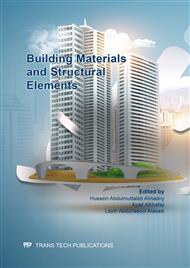[1]
Al-Mufty, A. & Nashat, I., (2000), Gypsum Content Determination in Gypseous Soils and Rocks,, 3rd International Jordanian Conference on Mining, Vol. 2, Amman, Jordan, pp.485-492.
Google Scholar
[2]
Assadi-Langroudi, A., Jefferson, I., (2013). Collapsibility in Calcareous Clayey Loess: a Factor of Stress-hydraulic History,, International Journal of Geomate 5 (1), pp. 620e627.
DOI: 10.21660/2013.9.62312
Google Scholar
[3]
ASTM D5333 (2003), Standard Test Method for Measurement of Collapse Potential of Soils,. Annual Book of ASTM Standards, Vol.04.08, Philadelphia, PA, ASTM, USA. Copyright, ASTM International, 100 Barr Harbor Drive, PO Box C700, West Conshohocken, PA 19428-2959, United States.
DOI: 10.1002/ep.670180104
Google Scholar
[4]
ASTM D854 (2010), Standard Test Methods for Specific Gravity of Soil Solids by Water Pycnometer1,. Annual Book of ASTM Standards, Vol.04.08, Philadelphia, ASTM, USA. Copyright, ASTM International, 100 Barr Harbor Drive, PO Box C700, West Conshohocken, PA 19428-2959, United States.
DOI: 10.1002/ep.670180104
Google Scholar
[5]
ASTM standard D-422, 2007: Standard Test Methods for Particle-size Analysis of Soils,. Annual Book of ASTM Standards, ASTM International, West Conshohocken, PA.
Google Scholar
[6]
ASTM D4253-16. Standard Test Method for Maximum Index Density and Unit Weight of Soils Using a Vibratory Table,, ASTM.
Google Scholar
[7]
ASTM D4254-16. Standard Test Methods for Minimum Index Density and Unit Weight of Soils and Calculation of Relative Density,, ASTM.
DOI: 10.1520/d4254-00r06e01
Google Scholar
[8]
ASTM D1556-15, Standard Test Method for Density and Unit Weight of Soil in Place by Sand-Cone Method,, ASTM International, West Conshohocken, PA.
Google Scholar
[9]
ASTM D3080-07. Standard Test Method for Direct Shear Test of Soils Under Consolidated Drained Conditions,, ASTM International, West Conshohocken, PA.
DOI: 10.1520/d3080_d3080m
Google Scholar
[10]
BS 1377 - 1990: Methods of Testing Soils for Civil Engineering Purposes". Clemence, S.P., and Finbarr, A.O. (1981). "Design Considerations for Collapsible Soils,, Journal of the Geotechnical Engineering Division, American Society of Civil Engineers, Vol. 107, GT3, pp.305-317.
DOI: 10.1061/ajgeb6.0001102
Google Scholar
[11]
Beckwith and Hansen,( 1989). Characterization of a Site Underlain by Deep Collapsing Soils, ASCE Library.
Google Scholar
[12]
Clemence, S. P., and Finbarr, A. O., (1981), Design Considerations for Collapsible Soils,, Journal of the Geotechnical Engineering Division, ASCE. Vol. 107, No. GT3, Proc. Paper, 16106. ed. 1981. pp.305-317.
DOI: 10.1061/ajgeb6.0001102
Google Scholar
[13]
Day, R.W., 2001. Soil Testing Manual. 1st Edn., McGraw- Hill, New York, ISBN: 0-07-136363-7.
Google Scholar
[14]
Fattah, M. Y., Al-Ani, M. M., Al-Lamy, M. T. A., (2013), Treatment of Collapse of Gypseous Soils by Grouting,, Proceedings of the Institution of Civil Engineers, Ground Improvement Journal, UK,.
DOI: 10.1680/grim.11.00020
Google Scholar
[15]
Fattah, M. Y., Al-Ani, M. M., Al-Lamy, M. T. A., (2015), Wetting and Drying Collapse Behavior of Collapsible Gypseous Soils Treated by Grouting,, Arabian Journal of Geosciences, Vol. 8, No. 4, p.2035–2049, DOI 10.1007/s12517-014-1329-7, Springer.
DOI: 10.1007/s12517-014-1329-7
Google Scholar
[16]
Fattah, M. Y., Dawood, B. A., (2020), Time-Dependent Collapse Potential of Unsaturated Collapsible Gypseous Soils,, World Journal of Engineering, Vol. 17 No. 2, pp.283-294.,.
DOI: 10.1108/wje-09-2019-0276
Google Scholar
[17]
Jennings, J. and Knight, K. (1975), A guide to construction on or with materials exhibiting additional settlement due to collapse of grain structure,, Proceedings of 6th Regional Conference for Africa on soil mechanics and Foundation Engineering, Durban, South Africa, pp.99-105.
Google Scholar
[18]
Lutenegger, A. J. and Hallberg, G. R. (1988). Stability of Loess,, Engineering Geology, 25, pp.247-261.
DOI: 10.1016/0013-7952(88)90030-0
Google Scholar
[19]
Singh, S. (2017), Microstructural Analysis of Clay after Treatment with Terrasil – A Nano Chemical,, International Journal of Scientific & Engineering Research, Vol. 8, Issue 12, pp.42-47.
Google Scholar
[20]
Rizvi, S., RientieS B., & R Olli .(2018). Investigation of temporal dynamics I n MOOC Learning at the AIED 2018:Artificial Intelligence in education, London.
DOI: 10.1007/978-3-319-93846-2_99
Google Scholar
[21]
M. A. Taha, N. A. E‐Mahallawy, T. M. Mousa, R. M. Hamouda, A. F. A. G. Yousef. (2012). Microstructure and castability of lead‐free silicon brass alloys.
DOI: 10.1002/mawe.201200932
Google Scholar
[22]
M.S. Nouaouria ⁎, M. Guenfoud, B. Lafifi. (2008) . Engineering properties of loess in Algeria, Science Direct Engineering Geology 99 (2008) 85–90.
DOI: 10.1016/j.enggeo.2008.01.013
Google Scholar
[23]
Andre Nel, Tian Xia, Lutz Madler, Ning L.(2006). Toxic Potential of Materials at the Nano level. , Science 311,622.
Google Scholar
[24]
Zaid Hameed Majeed and Mohd Raihan Taha. (2013). A Review of Stabilization of Soils by using Nanomaterials. Australian Journal of Basic and Applied Sciences, 7(2): 576-581.
Google Scholar


